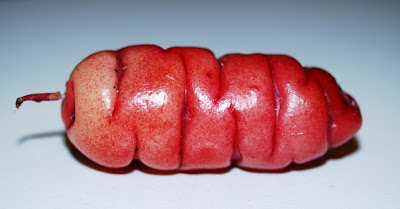Crumson and clover (this kiwi yam is an oca)
This chubby, humanoid (or fully inflated naked-mole-rat*) root grows in the steppes of the Andes in South America and in farmlands in New Zealand. It's produced by a clover and sold under the name of yam in New Zealand. Elsewhere it's called oca, which coincidentally has a very Australian ring to it.
Across the Tasman, yam is what we call a local daisy, Microseris lanceolata (or sometimes Microseris scapigera). It's also called the Native Dandelion which tells your pretty much what it looks like, and the local Aboriginal people in southern Australia call it the Myrnong.
In New Zealand, where this Microseris lanceolata also (sort of - see below) grows, I'm not sure there is a common name for it - you see the name 'yam' flung around occasionally but I wonder if that has been borrowed more recently from Australia. I couldn't find a Maori name.
As it happens there seem to be a few species lurking under the name lanceolata/scapigera and none of them are likely to be the same as the Microseris from New Zealand. That's something for my botanical colleagues to sort out while I return to subterranean concerns.
Outside Australia and New Zealand, yam usually refers to something from the genus Dioscorea, which also includes remarkable plants such as Elephant's Foot Yam (Dioscorea elphantipes; not to be confused with the grape relative called Elephant's Foot...). In North America the sweet potato, Ipomoea batatas, may be called a yam but as is oft said, they do things differently over there.
Yam is not an Aboriginal or Maori name of course. It seems to have been repatriated from Africa in the late sixteenth century by the Portuguese or Spanish, and perhaps later and independently by North Americans. Now it gets applied to pretty much anything with an edible tuber.
The New Zealand yam, the one I've photographed here, is Oxalis tuberosa: a clover with a well developed tuber. Lynda brought a few home from a guided tour by Janet O'Hehir of the Burnley campus of the University of Melbourne, home to its horticultural school and the odd food option.
In a review of the natural distribution of the oca and it's relatives, Eve Emshwiller from the Field Museum in Chicago urges us to protect the wild relatives of Oxalis tuberosa in western South America. You never know when you might need to breed in some of the genes from these plants to help maintain oca as a food source locally and in...well, at the moment, New Zealand.
Here in Australia you don't see much of the oca in our homes or markets. I'm sure it will become more popular as our palate develops and we seek out new flavours and sensations - a symptom of the modern Australian culture becoming mature?
What did our's taste like? I'd describe it as slightly sweet, crunchy and quite watery. It only tastes like potato (to which it is often compared) in the sense that crocodile and every other pale exotic meat tastes like chicken. Not unpleasant although Lynda suggested adding 'earthy' to the tasting notes. Which reminds me, did I wash it?
*A picture of the naked mole rat...




Comments